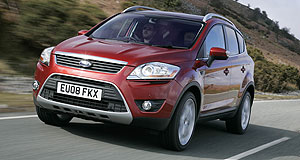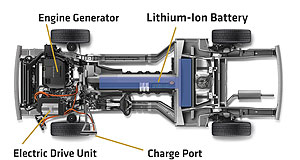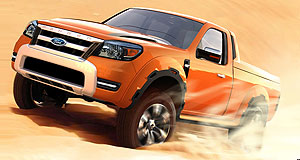
By BYRON MATHIOUDAKIS
Ford is awaiting petrol and auto availability before committing to the Kuga SUV
FORD says it is being very cautious with the decision to bring the Kuga into Australia.
The Focus-based compact SUV is being eyed as a potential replacement for the ageing Escape, which has been on sale in Australia since early 2001.
However, the Kuga has been held back until now due to the lack of a suitable powertrain combination for Australia.
Until this month, the German-built Ford has only been available with a 100kW 2.0-litre TDCi turbo-diesel variant mated to a six-speed manual gearbox.
And although rave reviews have been heaped upon the Kuga in this configuration, it is clear to Ford that Australians must have a petrol-powered and/or automatic gearbox in the model mix.
In fact, from December 1, Ford of Europe announced the addition of a Volvo-sourced 2.5-litre in-line five-cylinder petrol engine for Continental Kugas in six-speed manual and five-speed automatic guises, as well as a front-wheel drive TDCi model to complement the existing all-wheel drive versions.
It seems certain that Ford is awaiting the introduction of a four-cylinder model with automatic gearbox availability - be it the TDCi with the new Powershift dual-clutch sequential manual gearbox, or an engine such as the 2.3-litre petrol unit with a six-speed automatic, as fitted to the MA Mondeo.
The Kuga is closely related to the Focus underneath the skin, since they both leverage a variation of Ford’s C1 global small-car platform. Ford Australia has even admitted it will be technically possible for it to produce the Kuga here post 2011, when the next-generation Focus will be manufactured locally.
According to Ford’s recently installed vice-president of sales and marketing, Beth Donovan, getting the right model mix for Kuga in Australia is essential before giving the green light.
“That small utility segment – to me – doesn’t have an entry with anything like it - so it’s a huge opportunity.
“On the other hand, I need the customer to tell me that as well. Today it only comes as a diesel manual, and that’s a concern.
“When they get an automatic, then that’s when it is going to be more of a consideration for us, as well as a petrol.
“And then it comes down to where it is going to fit in that segment of the market.
“I don’t think anybody is interested in bringing something in, and then only to sell a few hundred of.”
As with other potential European Fords that are as yet unavailable in the Australian market such as the widely-acclaimed S-Max people-mover and Mondeo wagon, Mrs Donovan says that there is still plenty more research that needs to be done to make sure that demand actually exists out there.
“I’d like to get the customer to tell (Ford) what they like,” she reiterated.
FORD says it is being very cautious with the decision to bring the Kuga into Australia.
The Focus-based compact SUV is being eyed as a potential replacement for the ageing Escape, which has been on sale in Australia since early 2001.
However, the Kuga has been held back until now due to the lack of a suitable powertrain combination for Australia.
Until this month, the German-built Ford has only been available with a 100kW 2.0-litre TDCi turbo-diesel variant mated to a six-speed manual gearbox.
And although rave reviews have been heaped upon the Kuga in this configuration, it is clear to Ford that Australians must have a petrol-powered and/or automatic gearbox in the model mix.
In fact, from December 1, Ford of Europe announced the addition of a Volvo-sourced 2.5-litre in-line five-cylinder petrol engine for Continental Kugas in six-speed manual and five-speed automatic guises, as well as a front-wheel drive TDCi model to complement the existing all-wheel drive versions.
It seems certain that Ford is awaiting the introduction of a four-cylinder model with automatic gearbox availability - be it the TDCi with the new Powershift dual-clutch sequential manual gearbox, or an engine such as the 2.3-litre petrol unit with a six-speed automatic, as fitted to the MA Mondeo.
The Kuga is closely related to the Focus underneath the skin, since they both leverage a variation of Ford’s C1 global small-car platform. Ford Australia has even admitted it will be technically possible for it to produce the Kuga here post 2011, when the next-generation Focus will be manufactured locally.
According to Ford’s recently installed vice-president of sales and marketing, Beth Donovan, getting the right model mix for Kuga in Australia is essential before giving the green light.
“That small utility segment – to me – doesn’t have an entry with anything like it - so it’s a huge opportunity.
“On the other hand, I need the customer to tell me that as well. Today it only comes as a diesel manual, and that’s a concern.
“When they get an automatic, then that’s when it is going to be more of a consideration for us, as well as a petrol.
“And then it comes down to where it is going to fit in that segment of the market.
“I don’t think anybody is interested in bringing something in, and then only to sell a few hundred of.”
As with other potential European Fords that are as yet unavailable in the Australian market such as the widely-acclaimed S-Max people-mover and Mondeo wagon, Mrs Donovan says that there is still plenty more research that needs to be done to make sure that demand actually exists out there.
“I’d like to get the customer to tell (Ford) what they like,” she reiterated.











 Such a move could mean the end of, or at least a radical shift for, the popular and iconic Falcon-based utes as we know them. It could also see the end of Falcon ute production in Australia, which in turn could see the Ranger – which is currently built in Thailand – rolling down the assembly line at Ford Australia’s Broadmeadows plant in Victoria.
Such a move could mean the end of, or at least a radical shift for, the popular and iconic Falcon-based utes as we know them. It could also see the end of Falcon ute production in Australia, which in turn could see the Ranger – which is currently built in Thailand – rolling down the assembly line at Ford Australia’s Broadmeadows plant in Victoria.









